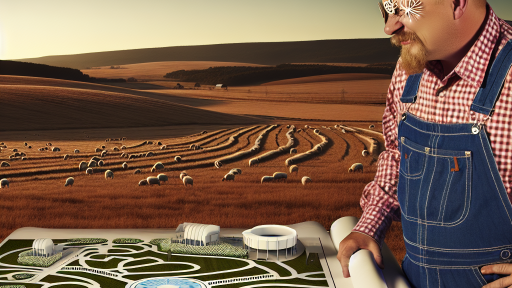Introduction to Crop Rotation and Its Importance for Soil Health
Crop rotation involves alternating the types of crops grown on a specific piece of land.
This practice enhances soil health and promotes sustainable agriculture.
By rotating crops, farmers can manage soil nutrients and reduce pests effectively.
Moreover, diverse crop planting helps maintain a balanced ecosystem.
Benefits of Crop Rotation
One key benefit of crop rotation is the reduction in soil erosion.
Different crops have varying root structures, which helps stabilize the soil.
Additionally, rotating crops improves soil structure and fertility.
It also helps increase organic matter in the soil, benefiting microorganisms.
Pest and Disease Management
Crop rotation disrupts pest and disease life cycles, reducing infestations.
This method limits the abundance of host plants for specific pests.
As a result, farmers can avoid excessive pesticide use.
Healthy soils contribute to plant resilience against disease.
Nutrient Management
Different crops have distinct nutrient requirements.
Crop rotation allows for natural replenishment of soil nutrients.
For instance, leguminous crops can fix nitrogen levels in the soil.
Transform Your Agribusiness
Unlock your farm's potential with expert advice tailored to your needs. Get actionable steps that drive real results.
Get StartedThis process minimizes the need for chemical fertilizers, promoting sustainability.
Environmental Impact
Practicing crop rotation contributes to improved environmental health.
It enhances biodiversity, supporting a wider range of species.
Furthermore, this approach can mitigate greenhouse gas emissions.
Overall, crop rotation serves as a key strategy in fighting climate change.
Implementing Crop Rotation
Farmers can employ several strategies for effective crop rotation.
Certain factors, like climate, soil type, and crop choice, are essential considerations.
Creating a rotation plan that includes a variety of crops is crucial.
For instance, a combination of grains, legumes, and cover crops can work well.
The Science Behind Crop Rotation
Nutrient Cycling
Crop rotation enhances nutrient cycling in the soil.
Different plants utilize varying amounts of nutrients.
This diversity helps replenish soil nutrients more effectively.
Leguminous crops, like soybeans, fix nitrogen in the soil.
Rotating these with nitrogen-demanding crops boosts soil fertility.
Thus, farmers minimize the need for synthetic fertilizers.
Soil Structure Improvement
Crop rotation contributes to better soil structure.
It prevents soil compaction, promoting better air circulation.
Deep-rooted plants break up compacted layers below the surface.
This enhances water infiltration and retention in the soil.
A well-structured soil supports healthy crop growth.
Additionally, varied root systems improve biodiversity in the soil ecosystem.
Minimizing Pest and Disease Pressure
Crop rotation can lower pest and disease incidences.
Certain pests thrive on specific crops alone.
Shifting crops disrupts their life cycles, reducing their populations.
Showcase Your Farming Business
Publish your professional farming services profile on our blog for a one-time fee of $200 and reach a dedicated audience of farmers and agribusiness owners.
Publish Your ProfileConsequently, farmers can diminish the use of pesticides.
This practice supports ecological farming and promotes healthier ecosystems.
Long-Term Sustainability
Implementing crop rotation leads to long-term sustainability in agriculture.
It fosters soil health, ensuring continuous productivity.
This sustainable approach supports food security for future generations.
Moreover, it allows for the conservation of natural resources.
Farmers embracing crop rotation invest in the planet’s future.
Common Crop Rotation Practices and Their Benefits
Introduction to Crop Rotation
Crop rotation is a sustainable agricultural practice.
It involves alternating the types of crops grown in specific fields.
This method enhances soil health and reduces pest infestations.
Benefits of Crop Rotation
Crop rotation offers numerous advantages for soil health.
It improves soil fertility by diversifying nutrient usage.
Additionally, it helps in preventing soil erosion.
Moreover, this practice enhances water retention in the soil.
Common Crop Rotation Practices
There are several common practices farmers use.
One popular method is the three-year rotation system.
This system often includes corn, soybeans, and wheat.
Another practice involves a legume cover crop after a main crop.
Legumes enhance nitrogen levels in the soil.
Rotation with Cover Crops
Including cover crops between main crop cycles is effective.
These crops can prevent weeds and soil erosion.
They also contribute organic matter when tilled into the soil.
Complementary Planting Strategies
Certain plants benefit from companion planting techniques.
For example, planting garlic can repel harmful insects.
Furthermore, certain crops like tomatoes and basil thrive together.
This synergy leads to healthier plants and improved yields.
Long-Term Sustainability of Crop Rotation
Over time, crop rotation promotes long-term agricultural sustainability.
It reduces dependency on chemical fertilizers and pesticides.
Farmers adopting this practice often notice increased yields.
They also benefit from healthier ecosystem interactions.
Uncover the Details: Crop Rotation and Carbon Sequestration Strategies
Understanding Soil Composition
Defining Soil Composition
Soi l composition refers to the mixture of organic and inorganic materials in the soil.
This mixture includes minerals, organic matter, air, water, and microorganisms.
The balance of these components significantly affects soil health.
Impact of Different Crops
Different crops interact uniquely with soil composition.
Some crops enhance nutrient levels while others may deplete them.
For instance, legumes fix nitrogen in the soil.
This process enriches the soil for the following crops.
Crop Rotation Benefits
Crop rotation helps maintain a balanced soil composition.
By alternating crops, farmers can prevent soil depletion.
Showcase Your Farming Business
Publish your professional farming services profile on our blog for a one-time fee of $200 and reach a dedicated audience of farmers and agribusiness owners.
Publish Your ProfileThis practice also mitigates pest and disease pressure.
Furthermore, crop rotation improves overall soil structure.
Specific Effects of Common Crops
Corn requires a high nitrogen level in the soil.
After corn, planting legumes like soybeans can replenish nitrogen.
Root crops, such as carrots, aerate the soil through their growth.
Moreover, cover crops protect soil from erosion during off-seasons.
Managing Soil pH
The pH level of soil affects the availability of nutrients.
Acidic soils can limit nutrient uptake by plants.
This is where crop rotation can play a critical role.
Diverse crops can contribute to stabilizing pH levels.
Improving Soil Microbial Activity
Different crops support diverse microbial communities in the soil.
Healthy microbes enhance nutrient cycling and organic matter decomposition.
Additionally, they help in disease suppression and soil structure improvement.
Thus, crop diversity contributes significantly to enhanced microbial life.
Key Points on Soil Health and Crop Management
Understanding soil composition is foundational for effective agriculture.
Different crops affect soil health in varied ways.
Utilizing crop rotation can significantly boost soil vitality.
This sustainable practice ultimately leads to successful farming.
Find Out More: Sustainable Farm Layout Techniques And Best Practices
Integrative Pest Management through Crop Rotation
Understanding Crop Rotation
Crop rotation involves alternating the types of crops grown in a specific area.
This practice diversifies soil nutrients and disrupts pest life cycles.
Additionally, it minimizes the risk of disease and pest infestations.
Benefits of Crop Rotation for Pest Management
Crop rotation enhances pest control naturally.
Different crops attract varying pests, reducing their population density.
Rotating crops also improves soil structure and fertility.
Moreover, certain plants can suppress weed growth effectively.
Implementing an Effective Rotation Strategy
Choosing complementary crops is essential for effective rotation.
Consider planting legumes, which fix nitrogen and benefit subsequent crops.
Use a three- to four-year rotation cycle to maximize benefits.
Record crop history to refine future planting strategies.
Monitoring and Adjustments
Regularly monitor pest populations to gauge the effectiveness of your rotation plan.
Adjust your strategy based on observed results and pest activity patterns.
Incorporate organic pest management techniques to enhance rotation benefits.
For instance, interplanting with pest-repellent species can add an extra layer of protection.
Learn More: No-Till Farming To Enhance Soil Regeneration

Case Studies: Successful Crop Rotation Strategies in Various Climates
Tropical Climate Success: The Rodriguez Family Farm
The Rodriguez family operates a successful farm in the tropics.
They implement a diverse crop rotation strategy every season.
This strategy includes soybeans, corn, and cassava.
As a result, their soil health has improved significantly.
They report stronger yields and fewer pests.
Showcase Your Farming Business
Publish your professional farming services profile on our blog for a one-time fee of $200 and reach a dedicated audience of farmers and agribusiness owners.
Publish Your ProfileFurthermore, nutrients in the soil remain balanced throughout the year.
Temperate Climate Achievement: Green Valley Collective
The Green Valley Collective is based in a temperate zone.
They rotate potatoes, oats, and clover each planting season.
Utilizing this rotation enhances soil structure and fertility.
Members of the collective appreciate the increase in earthworm populations.
This shift indicates healthier soil ecosystems, benefiting all crops.
Arid Region Innovations: Desert Oasis Farming
Desert Oasis Farming operates in an arid region.
They focus on rotation between barley, legumes, and sorghum.
This rotation conserves water and improves moisture retention.
Additionally, it enhances nitrogen levels in the soil.
Farmers report resilience against drought conditions as a result.
Continental Climate Strategies: Midwest Growers Association
The Midwest Growers Association focuses on corn and soy rotation.
They practice crop cover techniques during the off-season.
This method prevents soil erosion and nutrient runoff.
Farmers within the association see a marked decrease in pests.
This strategy improves overall crop resilience and productivity.
Implications of Crop Rotation for Sustainable Agriculture
All these case studies demonstrate the power of crop rotation.
These strategies lead to healthier soils and higher yields.
Moreover, they promote sustainability across various climates.
Farmers are increasingly adopting these practices for long-term benefits.
You Might Also Like: Soil Microbes And Their Role In Regeneration
Challenges and Solutions in Implementing Crop Rotation
Understanding Common Challenges
Farmers often face resistance when changing traditional practices.
Some may lack knowledge about the benefits of crop rotation.
This knowledge gap can hinder the adoption of innovative techniques.
Initial setup costs can also deter farmers from implementing new methods.
Moreover, certain crops require specific conditions, complicating rotation plans.
Addressing Knowledge Gaps
Education programs can bridge the knowledge gap effectively.
Farmers should receive resources on the benefits of crop rotation.
Workshops can provide hands-on experiences and guidance.
Collaboration with agronomists can further enhance understanding.
Managing Costs and Resources
Considering cost-effective strategies can alleviate financial concerns.
Farmers may explore government grants for sustainable practices.
Additionally, they can gradually implement crop rotation plans.
This approach spreads the financial burden over several years.
Maximizing Crop Options
Diversifying crop selection can aid in effective rotation strategies.
Crop rotation must align with soil health and market demand.
Furthermore, using cover crops can improve soil fertility during off-seasons.
This will enhance the economic viability of rotating crops.
Community Support and Collaboration
Support from local agricultural cooperatives can prove valuable.
These organizations can offer resources and shared experiences.
Showcase Your Farming Business
Publish your professional farming services profile on our blog for a one-time fee of $200 and reach a dedicated audience of farmers and agribusiness owners.
Publish Your ProfileNetworking with other farmers creates avenues for knowledge exchange.
Ultimately, collaboration fosters a supportive community in agriculture.
Future Trends in Crop Rotation and Sustainable Farming Practices
Integration of Technology
Farmers increasingly adopt modern technology to enhance crop rotation.
Precision agriculture tools enable better monitoring of soil health.
Remote sensing technology helps farmers track crop development efficiently.
Utilizing data analytics optimizes decision-making in crop management.
Regenerative Agriculture Practices
Regenerative farming focuses on improving soil health through diverse crop rotations.
Farmers prioritize cover crops to build organic matter and prevent erosion.
These practices enhance nutrient cycling and promote biodiversity.
As a result, regenerative agriculture increases resilience against climate change.
Future Cropping Systems
Polyculture systems are gaining popularity in sustainable farming.
This approach involves growing multiple crops in one area, improving yields.
Crop diversity helps suppress pests and diseases naturally.
Farmers experiment with different combinations of crops for better outcomes.
Consumer Demand for Sustainability
Consumer preferences are shifting toward sustainably produced food.
Farmers respond by adopting crop rotation strategies that enhance sustainability.
Labeling initiatives inform consumers about eco-friendly farming practices.
This trend encourages transparency in the food supply chain.
Collaborative Farming Initiatives
Cooperatives and farming networks are emerging to share resources.
These collaborations facilitate knowledge sharing about effective crop rotation.
Farmers pool their resources for better access to sustainable inputs.
Such initiatives strengthen community resilience in agriculture.
Additional Resources
Cover Crops and Crop Rotation | Home
An Economic Perspective on Soil Health | Economic Research Service




